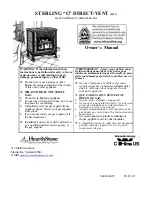
www.desatech.com
123715-01C
6
STORAGE
WARNING: Never attempt
to service heater while it is
connected to propane/LP supply,
operating, or hot. Severe burns
can occur. Any guard or other
protective device removed for
servicing must be replaced prior
to operating the heater.
1. Keep heater clean. Remove any debris
from ventilation openings.
2. Inspect heater before each use. Check
connections for leaks. Apply mixture of
liquid soap and water to connections.
Bubbles forming show a leak that must
be corrected. Correct all leaks at once.
OPERATION
Continued
SHUTDOWN INSTRUCTIONS
1. Press control knob and rotate clockwise
to OFF position.
2. Close propane/LP cylinder valve (rotate
knob clockwise).
BURNER OPERATION
Visually inspect burner for proper operation.
The burner should glow red with a minimum
amount of flame lap after initial firing. If flame
lap on burner is excessive, have heater ser-
viced. Pressure may be too high or nozzle/
burner may be damaged.
Figure 6 - Burner Operation
Correct
Flame
Pattern
Incorrect
Flame
Pattern
CAUTION: Disconnect heater
from propane/LP supply cylinder.
1. Do not store heater while attached to
propane/LP cylinder. Close cylinder valve.
Remove the hose/regulator assembly
from the propane/LP cylinder by turning
the fuel gas connector nut clockwise.
2. Storage of heater inside is permissible
only if the cylinder is disconnected and
removed from the appliance.
3. Store propane/LP cylinder in safe manner.
Refer to Chapter 5 of
Standard for Storage
and Handling of Liquefied Petroleum Gases,
ANSI/NFPA 58.
Follow all local codes.
Cylinders must be stored outdoors in a
well-ventilated area out of reach of children.
Disconnected cylinders must have threaded
valve plugs tightly installed, and must not
be stored in a building, garage or any
other enclosed area. Never store cylinders
near high heat, open flame, or where
temperatures exceed 100° F (38° C).
4. Store in a dry, clean, and safe place.
MAINTENANCE
3. Inspect hose/regulator assembly before
each use. If hose is highly worn or cut,
replace it immediately. At least annually,
remove hose/regulator assembly from
heater to inspect entire length of hose.
Replacement hose must be same type
as supplied with unit.
4. Spiders and insects can create a danger-
ous condition that may damage heater or
make it unsafe. Keep burner area clean
of all spiders, webs, or insects.
5. Have heater inspected yearly by a quali-
fied service person.







































